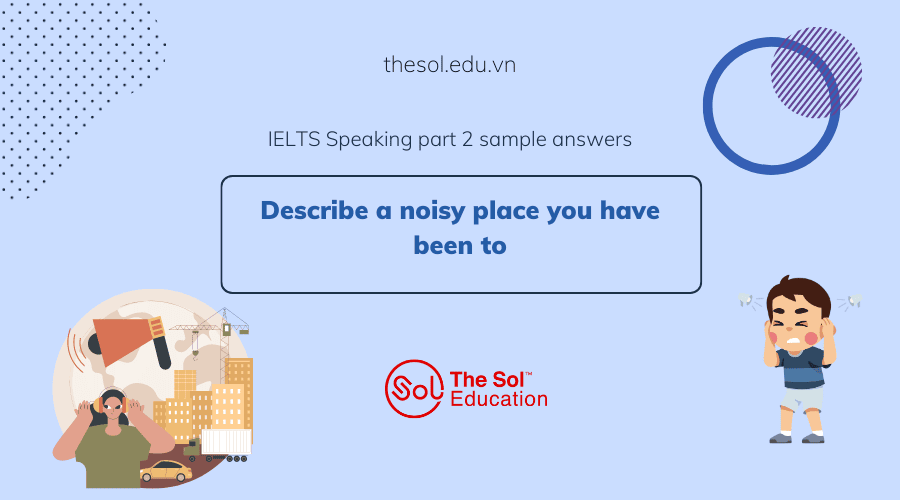Hãy cùng The SOL lên ý tưởng để trả lời cho câu hỏi IELTS Speaking part 2 Describe a noisy place you have been to (miêu tả một nơi ồn ào mà bạn đã từng đến) và các câu hỏi IELTS speaking part 3 sau đó nhé.

Chữa đề IELTS Speaking part 2 - miêu tả một nơi ồn ào bạn đã từng đến
Describe a noisy place you have been to
You should say:
Các bạn có thể tham khảo bài nói dưới đây từ The SOL Education để có thêm ý tưởng cho câu trả lời của mình nhé:
One of the noisiest places I have been to is the night market in the heart of Hanoi, Vietnam. This bustling night market is located in the Old Quarter, a vibrant and historic area known for its narrow streets and rich cultural heritage. I visited the night market during the summer vacation last year.
The moment I stepped foot into the night market, I was overwhelmed by the cacophony of sounds. The place was teeming with tourists, locals, and vendors all engrossed in their activities. The air was filled with the chatter of people bargaining, the clatter of cooking utensils from food stalls, and the blaring music from various street performers.
During my visit, I indulged in various activities. I strolled through the vibrant lanes, exploring the wide array of stalls selling clothing, accessories, souvenirs, and street food. I relished the delicious local delicacies, such as pho, banh mi, and fresh fruit smoothies. The vibrant atmosphere and the aroma of street food added to the sensory experience.
I consider the night market a noisy place due to the multitude of people and the diverse range of activities taking place simultaneously. It serves as a popular gathering spot for both locals and tourists, resulting in a constant buzz of conversations and bargaining. The music performances and street entertainers also contribute to the vibrant yet noisy ambiance.
While the noise level might be overwhelming for some, it is an integral part of the night market's charm. The lively atmosphere and the bustling crowd create a unique and immersive experience. The vibrant energy and the intermingling of different cultures make the night market an exciting and memorable destination for locals and tourists alike.
Một số từ vựng hữu ích được sử dụng trong bài nói trên:
Example: One of the noisiest places I have been to is the night market.
Example: This bustling night market is located in the Old Quarter.
Example: The Old Quarter is known for its vibrant atmosphere.
Example: The Old Quarter is known for its rich cultural heritage.
Example: I was overwhelmed by the cacophony of sounds.
Example: The place was teeming with tourists, locals, and vendors.
Example: The people were engrossed in their activities.
Example: The air was filled with the chatter of people bargaining.
Example: The clatter of cooking utensils filled the air.
Example: I relished the delicious local delicacies.
Example: The aroma of street food filled the air.
Example: The night market is a noisy place due to the multitude of people.
Example: The night market has a constant buzz of conversations and bargaining.
Example: The lively atmosphere is an integral part of the night market's charm.
Example: The night market offers an immersive experience for visitors.
Well, I believe that allowing children to make some noise can be beneficial for their development. It is a natural part of their growth and exploration process. Children often express themselves through play and communication, and making noise is a way for them to express their emotions and creativity. However, it is important to find a balance and teach them to be considerate of others.
While it is important to teach children about appropriate behavior and respect for others, completely restricting them from making any noise may hinder their social and cognitive development. Children should have the freedom to express themselves and engage in activities that may involve some level of noise. However, it is equally important to teach them when and where it is appropriate to make noise and how to be mindful of their surroundings.
In our daily lives, we encounter various types of noises. There are environmental noises such as traffic, construction, and natural sounds. Additionally, there are social noises such as conversations, laughter, and music. Technological noises from electronic devices and appliances are also common. Each type of noise contributes to the overall soundscape of our surroundings.
Generally, urban areas or cities tend to have higher levels of noise due to the dense population, traffic, and commercial activities. The constant hustle and bustle in cities can result in increased noise pollution. On the other hand, the countryside is usually quieter and more peaceful, with less human-induced noise. However, it's worth noting that some rural areas may have specific sources of noise, such as agricultural machinery or farm animals.
In my country, people typically respond to noises based on the context and their cultural norms. In urban areas, where noise pollution is more prevalent, individuals may become accustomed to certain levels of noise and adapt to them. However, excessive or disruptive noises can cause annoyance and frustration. People may take measures to minimize noise, such as using earplugs or soundproofing their homes. Politeness is also valued, and individuals are encouraged to be considerate and avoid creating unnecessary disturbances.
When chatting in public, people can consider others' feelings by being mindful of their volume and tone of voice. It's important to speak at an appropriate volume, avoiding being too loud or disruptive to others nearby. Additionally, using polite language and respectful manners can contribute to a positive and considerate conversation. Being aware of the surroundings and adjusting one's behavior accordingly shows respect for others and their right to a peaceful environment.
Tham khảo:
